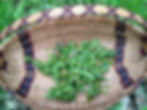Spring Greens
- Ed Joice
- May 7, 2023
- 4 min read

One of the greatest gifts each year is the welcome opportunity to get out into the woods after a long grey, winter and see brightly colored plants reaching up into the sky waking back up from the long night. To be able to identify and pick a few of those leafy greens to munch on while hiking or to collect for a salad is a godsend. Here's some of my favorite greens for you to try this spring. Prior to eating, be sure to confirm your identification using a field guide to wild plants. Also, worth noting: I am leaving out any plants that are classically considered, in the midwest, to be "weeds", as I'll be doing an article soon on edible weeds (such as dandelions, garlic mustard, stinging nettle, etc.).
Ostrich Fern (matteuccia struthiopteris)

My absolute favorite green to harvest and eat every spring here in Minnesota is the ostrich fern, ubiquitous throughout the state. Ostrich ferns can be found in the wild in wet areas in southern Minnesota or in coniferous forests up north, as well as in many gardens for its easy maintenance and elegant appearance. Typically folks recommend harvesting ostrich ferns when they are still "fiddleheads" and just poking up from the base of the plant. I've harvested and eaten fiddleheads that are up to a foot tall, but not ones whose fiddleheads have unfurled.
For a mature plant, there will be around 7 or 8 fronds per base of the plant and you can harvest two or three fiddleheads without harming the plant. For plants with only 4 to 6 fiddleheads, I would only harvest one fiddlehead, or just leave the plant be. Areas with fiddleheads typically have dozens or more plants in one spot so it's not difficult to harvest a large quantity and protect the plants at the same time. For identification, be sure the fiddlehead has a groove up the interior of the stalk, much like celery. This guarantees that you're eating an ostrich fern and not a different one that could taste bad or make you sick.

To cook these plants, first be sure to peel away the copper colored husk bits on the exterior of the fiddlehead. They can be gently sauteed or steamed and added as a standalone side or in corporated into a meal, as in eggs. I have also blanched them and tossed the fiddlehead tops into a salad for a crunchy addition. In many cases, I treat them as I would asparagus as they have a similar flavor and texture.
Ramps (allium tricoccum)
Ramps are one of the most beloved, popular, and controversial of all wild edible plants in the United States. Why?
Much like spring onions, leeks, garlic, and other plants of the allium genus, ramps concentrate a lot of their flavor in the bulb of the plant. Thus, the entire plant is often harvested for culinary purposes. This is all well and good for farmed domesticated plants, but for wild plants, such as ramps, it can lead be challenging for the plant populations to recover. For ramps in particular, overharvesting has led to eradication in certain areas. With that said, there are many areas where ramps grow extremely abundantly and overharvesting is a much smaller concern.

To properly identify a ramp, look for a large lance shaped leaf with a reddish stem that fades to a white base. There is a variant that lacks the reddish coloration on the stem but rather fades straight from green to white. Ramps have a garlicky, oniony odor and their leaves carry that flavor, making them a great addition to salads, sandwiches, and sauces. The bulbs, which should be harvested sparingly, are great used as a substitute for shallots or garlics and are also really nice when pickled.
Violet (violas spp.)

There are a number of lovely violet species, all of which offer edible greens and flowers. The edible flowers can be used to add some color and beauty to a dish, while still adding great flavor. Beyond that, they can be boiled with water and sugar to make a violet colored simple syrup that can add a floral element to a cocktail or dessert. The greens can be used raw in salad, steamed or even made into a tea.
Virginia Waterleaf (hydrophyllum virginianum)

This plant is very commonly found in rich deciduous forests, often along rivers but anywhere with healthy soil and shade. It often grows in decently sized patches as well. Viriginia waterleaf can be identified by its palmately compound leaves composed of three leaflets: two outer and one central. The two outer leaflets typically have two lobes each, whereas the central leaflet typically has three to five lobes. The lefthand most image above is a perfect image of Virginia waterleaf. Its namesake comes from the waterspots on the young leaves, though these often disappear with age. When young, the leaves make a delicious raw green for snacking on or tossing in a salad.
Trout Lily (erythronium albidum)
This plant get its name from the spots along the leaves that are reminiscent of the
patterns found on the brown or lake trout. It is a common plant found in similar areas to Virginia waterleaf and often is extremely abundant, completely blanketing large sections of forest. Every part of this plant is edible, from its flower to the leaves to the roots (called "corms"). I personally enjoy the juicy, raw leaves for their bright and lemony flavor that is a great green to mince as a finish to a dish, or to enjoy tossed in a salad to help make the dish sing. One warning, however, with trout lily is that some folks cannot tolerate it at all--it makes them nauseous. Most people shouldn't consume it in large quantities. A few leaves in a dish is more than enough.
Marsh Marigold (caltha palustris)

This lovely yellow buttercup flower can be seen blanketing wet areas along the edges of rivers and streams or on the periphery of bogs throughout the midwest. The tender, young leaves and the fresh buds of early spring are the only parts of this plant worth consuming, because as the plant ages its parts become tough and bitter. This plant cannot be eaten raw as it does contain a mild toxin that is removed via the cooking process. Cooking also helps to further tenderize the plant and releases some bitterness. Samuel Thayer recommends boiling with at least two changes of water and maybe even three. Next, consider sautéing in olive oil, salt, and garlic as one might do with swiss chard. Enjoy!








